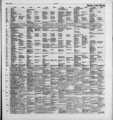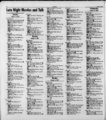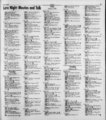| OCR Text |
Show DAILY Saturday, October 13, 2007 HERALD A9 Calif. 's drinldng water money in danger T Samantha Young and Erica Werner - THE ASSOCIATED 1 fZ PRESS SACRAMENTO, Calif. The mighty river delta that supplies water to of California's population and serves as one of the most important wildlife habitats on the West Coast is in worse shape than ever despite $4.7 billion in government spending. The ambitious venture two-thir- launched seven years ago to restore and protect the Sacramento-San Joaquin Delta has spent most of its budget on water projects hundreds of miles away, according to an Associated Press teview. While many of those projects are regarded by environmentalists and policymakers as worthwhile in their own right, they have done almost nothing to achieve the main goals state and federal lawmakers laid out when they created the California Federal Program, or CalFed. Scientists and politicians agree that native fish species continue to plummet; pesticides, fertilizers and other pollutants are making the overall water quality worse; invasive species of fish, clams, algae and other organisms are still spreading; and the delta's antiquated earthen levees have not been reinforced to withstand a major earthquake, something that could cause deadly, catastrophic flooding and cut off water to millions of people for perhaps years. "CalFed's a dismal failure Cal- because details aside Fed promisedtojstoFethe delta," said SfevT Evans, con- servation director of Friends of the River, an environmental group in Sacramento. "Over- all, the delta today is worse than it was seven years ago." Joe Grindstaff, director of CalFed for the past two years, acknowledged: "Fundamentally, the system we devised didn't work." The pools, channels and marshes in central California where the Sacramento River meets the San Joaquin River are the source of drinking water for 25 million Californians. Water is pumped from the delta vast, and delivered via aqueduct to booming Southern California, some 300 miles away, as well as to the San Francisco Bay area, about 40 miles off. Water is a precious re- Bay-Del- ta " .' f , ' ' - RICH Water rushes down a fish ladder, seen Creek near Manton, Calif. source in California, and in xecent decades, farmers, city dwellers arifferWirormiental- ists have waged legal battles that havfr threatened to interrupt or reduce the pumping of water from the delta. CalFed was supposed to achieve four objectives: maintain a steady supply of water from the delta; improve water quality; reduce the risks of a catastrophic breach in the levees; and restore the ecosystem for plants and animals. While CalFed was envisioned as a program, nearly all sides said they had expected to see more improvement by now. "It's tried to bring people to the table, but at the end of the day you have to look at results," said Rep. Devin Nunes, . "It appears that all the problems have gotten worse." Policymakers and environ 30-ye- at left, at a feeder-diversio- PEORONCELUAssociated Press dam that is scheduled to be replace by a modern fish ladder, on the North Fork of Battle n mentalists say the biggest danger is a levee collapse that could devastate the countryside. And if the delta's environmental health keeps declining, California could face more legal battles that could disrupt the water supply in the nation's most populous state. Already, partly because of CalFed's lack of progress, California's water wars are flaring anew. Over the summer, a federal judge slapped limits on the pumping of water from the delta to protect fish, raising fears of a statewide water shortage next year. APs review found that some CalFed efforts have fallen short. For example, the various agencies that carry out water projects under CalFed's aegis initially proposed spending $950 million to eliminate mercury and other contaminants from the delta water. But the agency has spent just 13 percent of that about $125 million and produced little if any improvement in water quality. Fourteen California and federal agencies have access to CalFed money. But CalFed does not full authority over how the money is spent. Its board, made up of state, federal and local officials as well as members of the public, can only sign off on grant requests. from the delta. (As envisioned by lawmakers, CalFed was supposed to improve water in the quality at the source delta itself.) More than $40 million to tear down five dams along Battle Creek, about 160 miles from the northern point of the delta, to restore 42 miles of habitat for salmon and steel-hea- d trout. I $118 million on studies to build or expand dams in Northern and Central Calif or-The $4.7 billion allotted to nia, three of which are outside . the program so far has been the delta. treated like a grab bag by the "Money was flying out the door all over the place," said agencies that have access to the money, with the vast maJeffrey Mount, chairman of the CalFed science panel. jority of it spent on hundreds of projects outside the Supporters of the agency's delta region. spending say some of the penamely, ripheral projects Among the expenditures: I $113 million to improve the water recycling and conservataste of tap water in Southern tion measures have indiCalifornia, hundreds of miles rectly eased pressure on the ty delta by generating enough drinking water for 4 million to 5 million people. In one example, the rapidly growing Chino area in Southern California, more than 300 miles from the delta, secured $1 million in CalFed money to help expand a wastewater recycling plant instead of pumping water out of the delta. "Everybody benefits by us reducing our demand for water out of the delta, so that's how we qualified," said Richard Atwater. eeneral manager of the Inland Empire Utilities Agency. sen. manne reinsrein, ica-lif- ., said in defense of CalFed: "CalFed was never meant to be the be-a- ll and end-al- l. It was a methodology to try to get the federal government and the state working together." REMEMBER OUR HEROES ON SUNDAY, NOVEMBER 11, IN THE Dh iLY HERALD'S ANNUAL VETERANS PAGE. For only $20 tell your hero how much you licnc r and respect them for their 1 CQur&ge and accomplishments, ijust fill out the form below and send in : a photo of your Veteran with payment to the Daily Herald- - Actfast! Veteran ads must be in by Wednesday, November 7th, 2007 at 5:00pm. r I I 1 I Want to Honor a Veteran! Veteran's Name: Mail to: Attn: Veterans Daily Herald P.O.Box 717 I P Where they served: ) Message: i Order not valid without the following information: Name (person placing the ad): Provo,UT Address: . ) City: I i . Home Phone: ( , State: .Day Phone: ) ( ). I Mastercard. I Visa Express. Sergeant John Smith United States Marine Corps .Check$Order. Vietnam Exp. Date:.L Card: I Signature: .Am , 84603 Zip: Date: . We're so proud of you! Love Your Family Your Tbwn. Your NV ighbon. Your Ntwppf f. ; |



























































